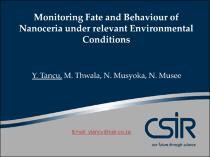 ResearchSpace
ResearchSpace
Monitoring fate and behaviour of Nanoceria under relevant environmental conditions
JavaScript is disabled for your browser. Some features of this site may not work without it.
- ResearchSpace
- →
- Research Publications/Outputs
- →
- Conference Publications
- →
- View Item
| dc.contributor.author |
Tancu, Y

|
|
| dc.contributor.author |
Thwala, Melusi

|
|
| dc.contributor.author |
Musyoka, Nicholas M

|
|
| dc.contributor.author |
Musee, N

|
|
| dc.date.accessioned | 2015-05-25T11:38:52Z | |
| dc.date.available | 2015-05-25T11:38:52Z | |
| dc.date.issued | 2014-11 | |
| dc.identifier.citation | Tancu, Y, Thwala, M, Musyoka, N and Musee, N. 2014. Monitoring fate and behaviour of Nanoceria under relevant environmental conditions. Proceedings of the 7th International Symposium on Macro- and Supramolecular Architectures and Materials (MAM-14). 23–27 November 2014 Johannesburg, South Africa | en_US |
| dc.identifier.uri | http://www.materialstoday.com/materials-chemistry/events/mam14/ | |
| dc.identifier.uri | http://hdl.handle.net/10204/7991 | |
| dc.description | Monitoring fate and behaviour of Nanoceria under relevant environmental conditions. Proceedings of the 7th International Symposium on Macro- and Supramolecular Architectures and Materials (MAM-14). | en_US |
| dc.description.abstract | The exponential use of engineered nanoparticles (ENPs) in commercial applications and of their resultant increasing release into the aquatic systems raises concerns as their potential impacts are unknown. According to the Organisation for Economic Co-operation and Development (OECD) ceria oxide nanoparticles (nCeO2) are among priority nanomaterials in need of immediate risk assessment owing to their increasing production and application in products. Herein we present findings on the transformation of nCeO2 nanoparticles exposed to varied concentrations and type of natural organic matter (humic acid and alginate) as a function of time; as well as pH using nanoparticle tracking analysis (NTA) and Transmission Electron Microscope (TEM). The results revealed significant tendency of nCeO¬2 to undergo aggregation, agglomeration and certain degree of deagglomeration processes under different environmental conditions. Moreover, the findings suggested that both electrostatic and steric interactions influenced the stability of the nanoparticles in aqueous media. Thus, nCeO2 stability kinetics is dependent on the physicochemical properties of the exposure media, and in turn plays a significant role with respect to risk assessment of ENPs including undergoing different forms of transformations after entry in the environment. | en_US |
| dc.language.iso | en | en_US |
| dc.publisher | Elsevier | en_US |
| dc.relation.ispartofseries | Workflow;14449 | |
| dc.subject | Aquatic media | en_US |
| dc.subject | Cerium oxide nanoparticles | en_US |
| dc.subject | Engineered nanoparticles | en_US |
| dc.subject | ENMs | en_US |
| dc.subject | Transformation | en_US |
| dc.title | Monitoring fate and behaviour of Nanoceria under relevant environmental conditions | en_US |
| dc.type | Conference Presentation | en_US |
| dc.identifier.apacitation | Tancu, Y., Thwala, M., Musyoka, N. M., & Musee, N. (2014). Monitoring fate and behaviour of Nanoceria under relevant environmental conditions. Elsevier. http://hdl.handle.net/10204/7991 | en_ZA |
| dc.identifier.chicagocitation | Tancu, Y, Melusi Thwala, Nicholas M Musyoka, and N Musee. "Monitoring fate and behaviour of Nanoceria under relevant environmental conditions." (2014): http://hdl.handle.net/10204/7991 | en_ZA |
| dc.identifier.vancouvercitation | Tancu Y, Thwala M, Musyoka NM, Musee N, Monitoring fate and behaviour of Nanoceria under relevant environmental conditions; Elsevier; 2014. http://hdl.handle.net/10204/7991 . | en_ZA |
| dc.identifier.ris | TY - Conference Presentation AU - Tancu, Y AU - Thwala, Melusi AU - Musyoka, Nicholas M AU - Musee, N AB - The exponential use of engineered nanoparticles (ENPs) in commercial applications and of their resultant increasing release into the aquatic systems raises concerns as their potential impacts are unknown. According to the Organisation for Economic Co-operation and Development (OECD) ceria oxide nanoparticles (nCeO2) are among priority nanomaterials in need of immediate risk assessment owing to their increasing production and application in products. Herein we present findings on the transformation of nCeO2 nanoparticles exposed to varied concentrations and type of natural organic matter (humic acid and alginate) as a function of time; as well as pH using nanoparticle tracking analysis (NTA) and Transmission Electron Microscope (TEM). The results revealed significant tendency of nCeO¬2 to undergo aggregation, agglomeration and certain degree of deagglomeration processes under different environmental conditions. Moreover, the findings suggested that both electrostatic and steric interactions influenced the stability of the nanoparticles in aqueous media. Thus, nCeO2 stability kinetics is dependent on the physicochemical properties of the exposure media, and in turn plays a significant role with respect to risk assessment of ENPs including undergoing different forms of transformations after entry in the environment. DA - 2014-11 DB - ResearchSpace DP - CSIR KW - Aquatic media KW - Cerium oxide nanoparticles KW - Engineered nanoparticles KW - ENMs KW - Transformation LK - https://researchspace.csir.co.za PY - 2014 T1 - Monitoring fate and behaviour of Nanoceria under relevant environmental conditions TI - Monitoring fate and behaviour of Nanoceria under relevant environmental conditions UR - http://hdl.handle.net/10204/7991 ER - | en_ZA |





